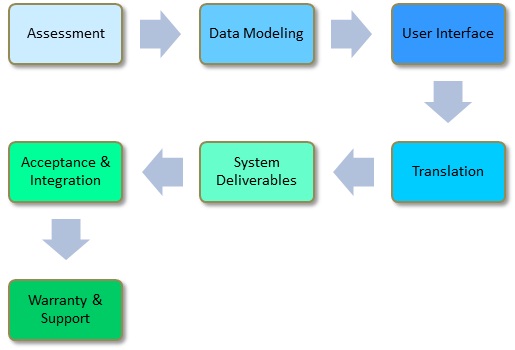Application Migration
Modernization projects are complex projects that have inherent risks. Companies that clearly define their success criteria tend to manage these risks better.
Solution Overview
In our experience, the four most important success criteria to successfully manage modernization projects are:
- Business processes championing customer product and solutions form the stepping stone for the modernized application. Despite legacy modernization being an IT project, it has strategic value to the organization and business owners and users are the catalyst and must be part of the core group for modernization.
- Modernization projects comprise of different phases where all stakeholders are involved to deliver the modernization project. There are complex inter-dependencies and this relationship must be understood and managed effectively for success of the project. Acceptance criteria are clearly stated so that tools, technology and processes are tuned to validate deliverables for the defined success criteria.
- Acceptance criteria cater not only to application functionality, but also to application architecture, coding guidelines, performance requirements, etc.
- Modernization initiatives cater to the desired IT roadmap for the organization.Therefore, it must be able to adopt customer-defined architecture, their choice of relational database and best-in-class methods, policies, tools and standards. Our automation support and tools for inclusion of framework, testing, data access methods and choice of client tier technologies cater to this.
Solution Lifecycle
Modernization project implementation rests on four pillars namely people, processes, technology and automation. These projects differ greatly from development projects which follow their own lifecycle. Our modernization project life cycle follows the seven stages as described below. A full-fledged governance frame work embrace all phases with tasks, metrics to measure and report, escalation to get the right resources and timely reporting to complete the project with in cost, time and quality.

Assessment Phase
This initial phase is to set the vision for modernization project. Based on the business drivers and future trends, the desired architecture is the starting point for the migration project. The legacy sources are captured and all dependencies are charted out. Project’s success criteria indicate the standards, tools, production system, migration guidelines and development platform.
Data Modeling Phase
This involves building the relational schema for the target platform. Based on the choice of the relational database, the current legacy data model and its structure are mapped to the new schema. When there are changes, they are published and released. The data migration policy is evolved and planned for test, development, production and archived data storage.
User Interface Phase
This is an important phase as it involves revising some of the workflow and technology supporting them. Each project can decide on the client framework like Thin Client, Thick client, Rich client with any popular tools and standards. Based on the choice of technology, the legacy screens would be revised for the look and feel of the revised corporate standards. This is an iterative process where our automation aids in transferring current style to new standards.
Translation Phase
This translation phase is where legacy programs are modernized. This is combining discovery of the way legacy programs are built, validating how legacy compilers and platform dependent methods are used and the path forward to transform to the required architecture, tools and standards. In this phase, migration team, modernization practices, target architecture and tools are fused to define the way our automation and supporting tools work together.
System Deliverables Phase
Here legacy applications are analysed for dependencies. Based on the business priority, programs are grouped based on the workflow and modernized. Migration team builds unit test guidelines and validates them against the modernized system. Automation tools are used to slice the codes into action blocks and based on the rules of modernization each action block is transformed to be compliant to the required architecture.
Acceptance & Integration Phase
Here test tools are used to build the application workflow and validate this with the modernized system. When there are deviations, they are tracked till they are resolved. Testing is a multi-tier process where user interface is first tested, functionality is checked, data flow is checked amongst programs and finally system integration is validated.
Warranty & Support Phase
This phase is to ensure that all application owners are trained and are capable of supporting the modernized application. Service levels are established to ensure that the system performs as needed.
We are innovators. We build automation tools. We support them with people & processes.
On-premise systems have been the backbone of businesses for decades. But technology & more importantly, the pace of change in technology has affected the way businesses run. We thrive on building bridges from older technologies to new ones. We use a judicious mix of forward & reverse engineering techniques to manage modernization; we make them predictable and risk-averse.